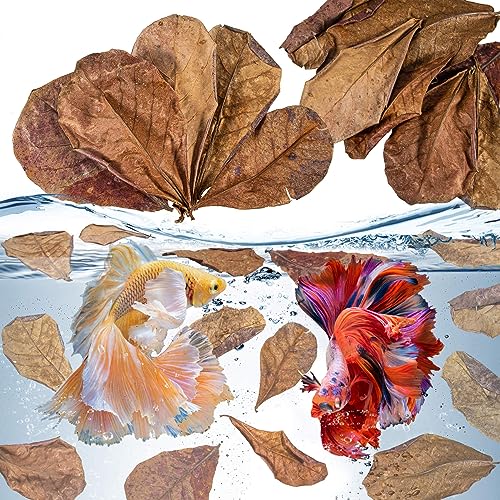As a betta fish owner, you might have heard about the importance of Indian almond leaves for betta fish. They are believed to help cure your betta’s bacterial or fungal infection and prevent any bacterial or fungal infections in the future. Is this claim true?
Well, there is little to no scientific evidence regarding the fact that they have healing properties. They have proved to help a lot of sick bettas revive. Along with their medicinal benefits, they can add to be a great food source for betta fry and help them stay protected. Indian almond leaves for betta also improve the tank quality and can give your tank water an aesthetic color change. This change in watercolor will only make your betta feel more comfortable because this somewhat represents its natural habitat more closely and makes it feel like home. Today in this post, we are going to know more about how Indian almond leaves for betta can be a good option.
What Are Indian Almond Leaves For Betta?

Indian almond leaves for betta are the desiccated leaves of the Terminalia catappa tree, which is typically found in the Southeast Asian region and has been employed in conventional and herbal medicine for ages there. Betta fish caretakers have utilized Indian almond leave for betta all over the world for a very long time now. This is because Indian almond leaves for betta have proven effective.
They are marketed as a homeopathic treatment for a variety of diseases and disorders that betta fish can suffer from. In Southeast Asia and India, these leaves are quite valued. Indian almond leaves are supposed to assist fight fungus and bacterial issues like fin rot, as well as minimize fish from being anxious by simulating their natural environment.
Betta fish in the wild where this Indian almond leaves naturally drops appear to be more infection immune, have tougher fins, tails, and good skin, and are generally physically active. As a result, breeders put the leaves in the betta tanks to provide their Bettas with the equivalent perks. Since then, even some informal betta keepers have adopted the method.
Collecting the leaves from the ground is the most common method of harvesting them. They are ideal to employ in aquariums once they have dried. Catappa leaves are another name for them.
5 Benefits Of Indian Almond Leaves For Betta:
The trees that provide the beneficial Indian almond leaves are thought to emit a compound that defends them by repelling predatory bugs. There’s a possible link between the insect-repelling compound released by the tree and the notion that these leaves lower the number of betta egg spoiling because of bacterial/fungal infestation.
However, this has never been verified. However, we are more interested in the benefits that it has been shown to bring. Here are a few examples.
Medicinal Perks
The Indian almond leaves for betta are majorly added to the betta tank when the betta becomes extremely sick. Introducing a couple of Indian almond leaves for a betta to an isolation tank with a sick betta will help heal wounds and fight against infections while also cleaning the tank water.
The tannins generated by Indian almond leaves are thought to combat bacteria, fungi, and pathogens, enabling damaged fish to recuperate faster. Indian almond leaves contain tannins and flavonoids that help fish recover faster. The Indian almond leaf has been advocated as a possible alternative to antibiotics and other treatments in the battle against germs and fungus in industrial fish aquaculture.
Enhancing Water Quality

Indian almond leaves can be beneficial when managing freshwater fish like betta, which enjoys gentle, acidic water conditions. The addition of Indian almond leaves can help to reduce the pH of the water in your tank. An Indian almond leaf will progressively decompose in your tank after being introduced.
As it does so, tannic acid, antioxidants, and other chemicals are released into your tank. Tannic acid decreases the pH of your tank when it is discharged. If you’re looking for a natural way to lower the pH measure in your tank, Indian almond leaf can assist. This will help it better mimic its natural environment and appear more at ease.
Food Source
Because several fish fry and brine shrimp like to graze on decomposing leaf waste, Indian almond leaves for betta fry are also employed as a starting food alternative. The Indian almond leaves might be consumed not only as a primary meal for betta fry or shrimp but also as a backup food supply if other supplies of food are short.
Furthermore, the leaves provide a hiding area for fry, enabling them to remain secure. Microorganisms known as infusoria develop as the Indian almond leaves decompose and eat on the leaf. Your betta fry will eat this till they reach the size where they require to shift to another food source.
For Reproduction
The leaves of Indian almond trees can help to stimulate reproduction. The tannins generated by the leaves aid in the creation of water parameters comparable to those found in the fish’s native environment, which aids in the replication of reproductive circumstances.
Many bettas will only reproduce in specific types of water. And the lower pH and alkalinity of the water could be just what your betta needs to breed. Bubble nests are also built by betta and gouramis on floating leaves.
Adding Color To Tank Water

Indian almond leaves can give your water a tinge of color. When immersed in a tank, these leaves yield some of their dark, murky color, similar to a teabag. This gloomy water appeals to betta fish. Native foliage, such as Indian almond leaves or other leaf litter, is essential for creating an Asian brackish water aqua space that mimics brook waterways.
As a result, introducing Indian almond leaves for betta to a tank will aid in better mimicking the tank water.
FAQs on Indian Almond Leaves For Betta
How do you use Indian almond leaves for betta?
The simplest method is to drop two almond leaves into the tank and wait patiently. If you want the tannic acid to flow faster, you can shred the leaves. You can remove the Indian almond leaves once they begin to deteriorate, but it’s also acceptable to allow them to break down; shrimps and fry will love it.
Do Indian almond leaves sink?
Initially, when you put Indian almond leaves in your aquarium, they will hover on the top surface level of water. It will sag after 3 to 5 days.
How long does it take for Indian almond leaves to work?
It will take 3-5 days for catappa leaves to settle, after which they will shed the majority of their tannin and initiate to disintegrate down. They usually live a month or two in your tank once submerged before decomposing.
Do you boil Indian almond leaves for betta?
No. Boiling these leaves might release all the beneficial tannins in the leaves and kill them. Introducing these leaves after boiling them is then a waste. Instead of boiling it, soak it.
Where can I buy Indian almond leaves for betta?
You can buy Indian almond leaves for betta online on any shopping platform like amazon, Petsmart, or chewy.
Final Thoughts:
Indian almond leaves for betta could be a prudent decision for your betta fish and fry. This will help you clone the natural habitat of betta as much as possible, making it feel relieved. It will also heal and prevent your betta from any sustainable bacterial or fungal infection, which could otherwise be fatal.












